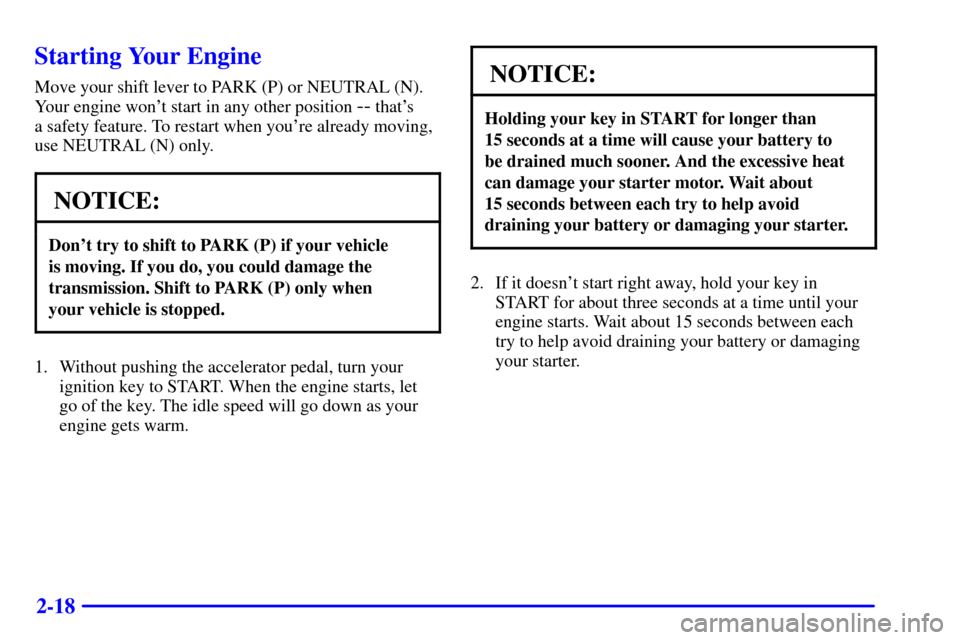Page 4 of 321
ii
Table of Contents
Keys and Door Locks
Remote Keyless Entry (RKE) System
Trunk Release
Automatic Transmission
Windows
Tilt Wheel
Turn Signal/Multifunction Lever
Windshield Wipers
Cruise ControlInterior and Exterior Lamps
Mirrors
Storage Compartments
Convenience Net
Accessory Power Outlet
OnStar® System (If Equipped)
Sunroof (Option)
HomeLink® Transmitter (Option)
Instrument Panel, Warning Lights and Gages Seats and Seat Controls
Safety BeltsAir Bag Systems
Child Restraints
Section
1
Section
2
Seats and Restraint Systems
Features and Controls
Page 66 of 321

2-
2-1
Section 2 Features and Controls
Here you can learn about the many standard and optional features on your vehicle, and information on starting,
shifting and braking. Also explained are the instrument panel and the warning systems that tell you if everything is
working properly
-- and what to do if you have a problem.
2
- 2 Keys
2
- 4 Door Locks
2
- 7 Remote Keyless Entry System (RKE)
2
- 11 Trunk
2
- 12 Theft
2
- 13 Theft-Deterrent System (Option)
2
- 15 Immobilizer
2
- 16 New VehicleªBreak-Inº
2
- 16 Ignition Positions
2
- 18 Starting Your Engine
2
- 19 Engine Coolant Heater (If Equipped)
2
- 21 Automatic Transmission Operation
2
- 26 Parking Brake
2
- 27 Shifting Into PARK (P)
2
- 29 Shifting Out of PARK (P)
2
- 30 Parking Over Things that Burn2
- 31 Engine Exhaust
2
- 31 Running Your Engine While You're Parked
2
- 32 Windows
2
- 34 Horn
2
- 34 Tilt Wheel
2
- 35 Turn Signal/Multifunction Lever
2
- 41 Exterior Lamps
2
- 47 Interior Lamps
2
- 48 Mirrors
2
- 50 Storage Compartments
2
- 53 OnStar� System (If Equipped)
2
- 54 Sunroof (Option)
2
- 58 HomeLink� Transmitter (If Equipped)
2
- 62 The Instrument Panel -- Your
Information System
2
- 66 Warning Lights, Gages and Indicators
Page 70 of 321

2-5 Power Door Locks
Push the side of the
power door lock switch
with the lock symbol to
lock all the doors.
Push the side of the switch with the unlock symbol to
unlock all the doors.
Automatic Door Locks
Close the doors and turn on the ignition. Every time you
move the shift lever out of PARK (P), all of the doors
will lock. The doors will also unlock every time you
stop the vehicle and move the shift lever into PARK (P).
If someone needs to get out while your vehicle is not in
PARK (P), have that person use the manual or power
door lock. When the door is closed again, it will not lock
automatically. Use the manual or power lock to lock the
door again.
Programmable Automatic Door Locks
Each remote keyless entry transmitter supplied with
your vehicle can be programmed to suit each driver's
door lock preference. The two remote keyless entry
transmitters are identified on the back with either a ª1º or
a ª2º. Each transmitter can be programmed separately.
The automatic door locks can be programmed (using the
remote keyless entry transmitter) for various lock and
unlock options.
With the ignition on, the transmission in PARK (P)
and the brake pedal pressed down, you are now ready
to begin programming.
Page 76 of 321

2-11
Trunk
CAUTION:
It can be dangerous to drive with the trunk lid
open because carbon monoxide (CO) gas can
come into your vehicle. You can't see or smell
CO. It can cause unconsciousness and even death.
If you must drive with the trunk lid open or if
electrical wiring or other cable connections must
pass through the seal between the body and the
trunk lid:
�Make sure all other windows are shut.
�Turn the fan on your heating or cooling
system to its highest speed with the setting
on AUTO and the temperature between
65�F (18�C) and 85�F (29�C). That will
force outside air into your vehicle.
See ªComfort Controlsº in the Index.
�If you have air outlets on or under the
instrument panel, open them all the way.
See ªEngine Exhaustº in the Index.
Trunk Release
To use this feature, your
transmission must be in
PARK (P). Press the trunk
release button located on the
center console next to the
radio to open the trunk.
You can also press the trunk button on the remote
keyless entry transmitter to access the trunk
compartment. Your vehicle doesn't have a trunk
key lock cylinder.
Page 77 of 321

2-12
If your vehicle loses power
temporarily, you can
manually open the trunk
using the trunk release
handle. The handle is
located on the underside
of the trunk lid on the
driver's side and can be
accessed through the
fold
-down rear seats.
Fold down the driver's side rear seat and reach through to
the trunk compartment to find the release handle. Pulling
the handle opens the trunk. For more information on
how to fold the rear seats, see ªFolding the Rear Seatº
in the Index.
Theft
Vehicle theft is big business, especially in some cities.
Although your vehicle has a number of theft
-deterrent
features, we know that nothing we put on it can make
it impossible to steal. However, there are ways you
can help.
Key in the Ignition
If you leave your vehicle with the keys inside, it's an
easy target for joy riders or professional thieves
-- so
don't do it.
When you park your vehicle and open the driver's door,
you'll hear a tone reminding you to remove your key
from the ignition and take it with you. Always do this.
Your steering wheel will be locked, and so will your
ignition and transmission. And remember to lock
the doors.
Page 82 of 321

2-17
With the key in the
ignition switch, you can
turn the switch to four
different positions.
LOCK (�): Before you put the key in, the ignition
will be in LOCK. This is the only position from which
you can remove the key. This position locks the
ignition, steering wheel and transmission. It's a
theft
-deterrent feature.
OFF (I): This position lets you turn off the engine
but still turn the steering wheel. It doesn't lock the
steering wheel like LOCK. Use OFF if you must
have your vehicle in motion while the engine is off
(for example, if your vehicle is being pushed).ON (II): The ignition is on in this position. ON is used
for driving your vehicle.
START (III): This position starts the engine.
To lock the steering column, remove the key while in
LOCK. Turn the steering wheel until you hear a click.
Retained Accessory Power (RAP)
The radio and the optional cellular phone are the only
accessories on your vehicle that may be used for up to
10 minutes after the ignition is turned to OFF or until
a door is opened.
Power to the door locks is available at all times. Power
to the fuel door and trunk release will be available
for 15 minutes after the ignition is turned to OFF.
The power window controls and the sunroof (optional)
controls are active until a door is opened
-- there is
no time limit as long as the doors remain closed.
Page 83 of 321

2-18
Starting Your Engine
Move your shift lever to PARK (P) or NEUTRAL (N).
Your engine won't start in any other position
-- that's
a safety feature. To restart when you're already moving,
use NEUTRAL (N) only.
NOTICE:
Don't try to shift to PARK (P) if your vehicle
is moving. If you do, you could damage the
transmission. Shift to PARK (P) only when
your vehicle is stopped.
1. Without pushing the accelerator pedal, turn your
ignition key to START. When the engine starts, let
go of the key. The idle speed will go down as your
engine gets warm.
NOTICE:
Holding your key in START for longer than
15 seconds at a time will cause your battery to
be drained much sooner. And the excessive heat
can damage your starter motor. Wait about
15 seconds between each try to help avoid
draining your battery or damaging your starter.
2. If it doesn't start right away, hold your key in
START for about three seconds at a time until your
engine starts. Wait about 15 seconds between each
try to help avoid draining your battery or damaging
your starter.
Page 86 of 321
2-21
Automatic Transmission Operation
There are several different
positions for the shift lever.
PARK (P): This position locks the transmission drive
shaft. It's the best position to use when you start the
engine because your vehicle can't move easily.CAUTION:
It is dangerous to get out of your vehicle if the
shift lever is not fully in PARK (P) with the
parking brake firmly set. Your vehicle can roll.
Don't leave your vehicle when the engine is
running unless you have to. If you have left the
engine running, the vehicle can move suddenly.
You or others could be injured. To be sure your
vehicle won't move, even when you're on fairly
level ground, always set your parking brake
and move the shift lever to PARK (P).
See ªShifting Into PARK (P)º in the Index.
If you're pulling a trailer, see ªTowing a Trailerº
in the Index.
Ensure the shift lever is fully in PARK (P) before starting
the engine.